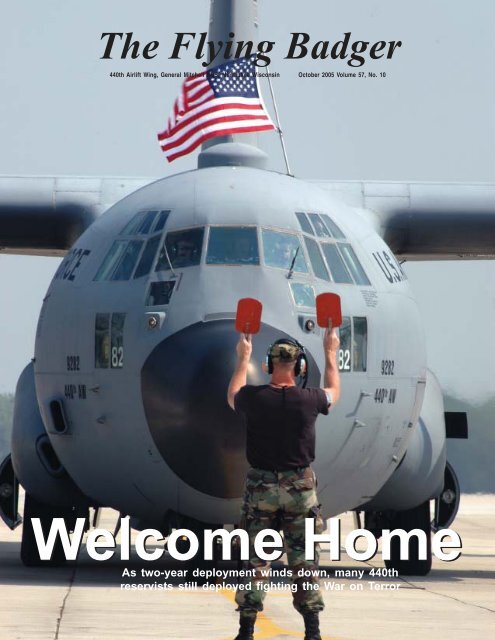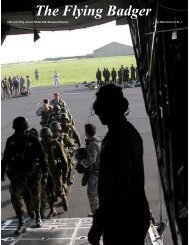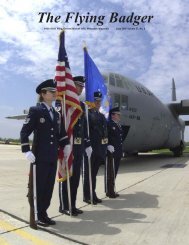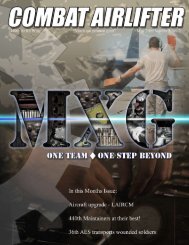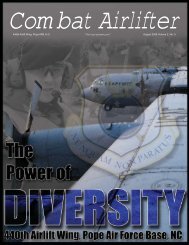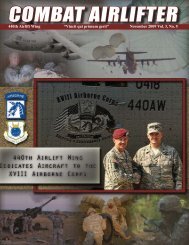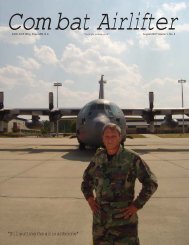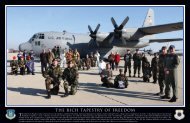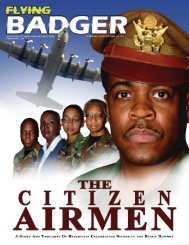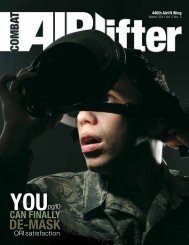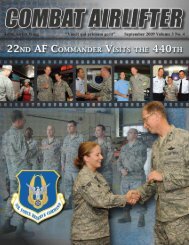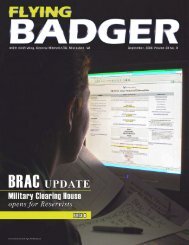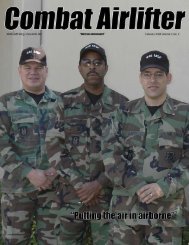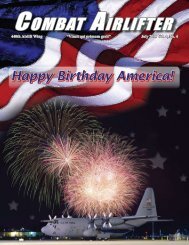October 05.pmd - 440th Airlift Wing
October 05.pmd - 440th Airlift Wing
October 05.pmd - 440th Airlift Wing
You also want an ePaper? Increase the reach of your titles
YUMPU automatically turns print PDFs into web optimized ePapers that Google loves.
The Flying Badger<br />
<strong>440th</strong> <strong>Airlift</strong> <strong>Wing</strong>, General Mitchell ARS, Milwaukee Wisconsin <strong>October</strong> 2005 Volume 57, No. 10<br />
Welcome Home<br />
As two-year deployment winds down, many <strong>440th</strong><br />
reservists still deployed fighting the War on Terror
On the cover...<br />
Family and friends eagerly<br />
await this <strong>440th</strong> C-130 as it<br />
returns from the Middle East<br />
Sept. 10.<br />
photo by Tech. Sgt. Bob Sommer<br />
The Flying Badger<br />
<strong>October</strong> 2005<br />
Volume 57 Number 10<br />
Contents of the Flying Badger are<br />
not necessarily the official view of,<br />
or endorsed by, the U.S.<br />
government, Department of<br />
Defense or Department of the Air<br />
Force. Content is compiled,<br />
originated and developed by the<br />
Public Affairs staff of the <strong>440th</strong><br />
<strong>Airlift</strong> <strong>Wing</strong>, Air Force Reserve<br />
Command.<br />
<strong>Wing</strong> Commander<br />
Col. Merle D. Hart<br />
Director, Public Affairs<br />
Dennis J. Mehring<br />
<strong>Wing</strong> Chief, Public Affairs<br />
Maj. Ann Peru Knabe<br />
Public Affairs Staff<br />
Capt. Keith Leistekow<br />
Tech. Sgt. Steve Staedler<br />
Staff Sgt. Denise Quasius<br />
Senior Airman Deanne Perez<br />
Airman Amanda Hill<br />
Ann F. Skarban<br />
Liz A. Stoeckmann<br />
JoAnn Lindner<br />
COMMAND PERSPECTIVE<br />
Life will move on<br />
for daughters, <strong>Wing</strong><br />
by Maj. Kent Hansen<br />
Commander, <strong>440th</strong> SFS<br />
I’ve refused to believe that the<br />
snares of father time would ever<br />
entrap me, but they have. This<br />
new consciousness of age and time<br />
occurred while I helped my older<br />
daughter, Wendi, move into the<br />
dormitory at her chosen university<br />
on Sept. 4. On top of that, my<br />
younger daughter, Lindsay, started<br />
high school on Sept. 7. As I<br />
pondered<br />
what these<br />
changes have<br />
wrought, it<br />
occurred to<br />
me, more<br />
clearly than<br />
ever, that time<br />
marches<br />
on…”it waits<br />
for no man,”<br />
I<br />
remembered<br />
my dad telling<br />
me on at least<br />
one occasion,<br />
“They [kids]<br />
grow up so<br />
quickly.”<br />
What he didn’t share was how this<br />
realization brings with it the feeling<br />
of antiquity and a related denial that<br />
these changes are potentially<br />
invigorating.<br />
Contemplating the changes in<br />
my personal life led me to think<br />
about the impending changes here<br />
at the 440 th . As I write this, we are<br />
The undaunted<br />
heart of this wing<br />
beats steadily as it<br />
has for more than 50<br />
years. It will continue<br />
its life-giving rhythm<br />
long into the future<br />
for it beats within<br />
each of us. Rest easy<br />
440 th , we will not fail.<br />
still awaiting our fate as an Air Force<br />
entity. There are questions to be<br />
answered regarding our respective<br />
futures. I’m betting there are as many<br />
or more questions as the number of<br />
people reading this article and<br />
unfortunately those questions may<br />
go unanswered for some time.<br />
The expanse of the unknown<br />
instills anxiety or fear in some of us<br />
and titillates or excites others.<br />
Individual emotions may vary but<br />
one fact is sure,<br />
we will all<br />
succeed if we set<br />
about to manage<br />
the changes in<br />
our lives. No<br />
matter what the<br />
final decisions<br />
are, and after a<br />
plan of<br />
operations<br />
emerges, we<br />
must accept the<br />
inevitable<br />
changes. We<br />
cannot afford to<br />
run from those<br />
decisions, nor<br />
should we allow<br />
ourselves to exhaust a lot of our time<br />
lamenting the endless possible<br />
courses of action that may result.<br />
Despite my selfish musings when<br />
I left Wendi at school, I also had<br />
occasion to consider what exciting and<br />
rewarding experiences lie in store for<br />
her. When I released my emotional<br />
hold on the event and considered the<br />
2005 440 AW Combined Federal Campaign Begins<br />
by Capt Michael Schaefer<br />
Maj. Kent Hansen<br />
opportunities and challenges this lifeevent<br />
would bring for my daughter,<br />
I began to embrace the concept and<br />
appreciate the event for what it truly<br />
was.<br />
Surely, we’ll all be affected in one<br />
way or another when the final<br />
decisions have been made regarding<br />
the future of the 440 th . By<br />
encouraging each other to embrace<br />
the event and consider the<br />
opportunities that lie ahead for us,<br />
we will succeed no matter the<br />
circumstances that face each<br />
individual. Seeking the opportunities<br />
that result, no matter where or when<br />
we may find them, will allow us to<br />
see this life-event for more of what<br />
it truly is and reap the rewards the<br />
changes may hold for us.<br />
The undaunted heart of this wing<br />
beats steadily as it has since the first<br />
members of the wing flew their first<br />
operational mission on June 6, 1944.<br />
I am certain that heart will continue<br />
its life-giving rhythm long into the<br />
future, for it beats within each of us.<br />
Rest easy 440 th , we will not fail.<br />
Flying Badger<br />
Editorial Contact<br />
Melissa Kimball<br />
Office of Public Affairs<br />
<strong>440th</strong> <strong>Airlift</strong> <strong>Wing</strong><br />
300 East College Avenue<br />
General Mitchell ARS, WI 53207<br />
Phone: 414-482-5481<br />
FAX: 414-482-5913<br />
www.afrc.af.mil/440aw<br />
Page 2 The Flying Badger <strong>October</strong> 2005<br />
The 440 th <strong>Airlift</strong> <strong>Wing</strong>’s Combined Federal Campaign (CFC) drive began Sept. 28, and we hope, with your<br />
help, to exceed a goal of $18,206. The CFC is an excellent way to help those in need, and allows people to choose<br />
the charity of their choice.<br />
Information on charities you can give to can be found on line at http://eastwicfc.org/. Click on the CFC<br />
brochure at that site.<br />
Unit representatives are available to help with forms and information. Contact your unit CFC representative<br />
with questions or these group contacts: Chief Master Sgt. Gail Biedenbender, Mission Sujpport Group; Master<br />
Sgt Thomas Payonk, Maintenance; Master Sgt Marlene Moore, Medical; Maj. Kyle Cioffero, Operations; Lt.<br />
Col. Larry Guenther, <strong>Wing</strong>; or . myself with any questions.<br />
Traditional reservists may only donate cash or by check. Payroll deduction is still available for civilians and<br />
ARTs.
FIT TO FIGHT<br />
Civilian loses weight, gains healthier life<br />
by Maj. Ann Peru Knabe<br />
In January 2004 Michael Taylor<br />
took a hard look at his life. The 440 th<br />
Human Resource Manager was<br />
overweight with high blood pressure<br />
and high cholesterol. These physical<br />
problems required him to take<br />
medication. It was time for action.<br />
After talking with his brothers<br />
and sisters who were experimenting<br />
with fad diets like the “fat flush,”<br />
Mr. Taylor decided to take a different<br />
route … the healthy one.<br />
Initially, he jumpstarted his new<br />
lifestyle by modifying the food he<br />
was eating. After a 10-pound weight<br />
loss in the first two weeks, his<br />
motivation increased, and Mr.<br />
Taylor purchased a cross-trainer<br />
exercise machine. He logged threeand-a-half<br />
miles one day, and four<br />
the next.<br />
As the pounds started to melt<br />
off, Mr. Taylor realized he needed<br />
to tone up his body for continued<br />
success.<br />
“I read that people need to add<br />
weight training to their workouts in<br />
addition to aerobic exercise,” he said,<br />
noting that he purchased a home gym<br />
to ensure he got regular resistance<br />
training into his exercise regime.<br />
Once spring rolled around, Mr.<br />
Taylor started walking three to four<br />
miles a day. “I rarely took off from<br />
this routine,” he said. “And I started<br />
drinking 64 ounces of water a day,<br />
while eliminating caffeinated<br />
beverages.”<br />
Although he describes the first<br />
six months of his new regime as<br />
“tedious,” Mr. Taylor was<br />
encouraged with the results as he<br />
tracked what he ate and how much.<br />
Gradually, he stopped the food logs,<br />
and instead just kept track of his<br />
weight.<br />
Today, he is 60 pounds lighter<br />
and full of energy. Mr. Taylor no<br />
longer takes high blood pressure<br />
medicine, and has significantly<br />
reduced his cholesterol levels. “I<br />
even sleep better,” he said. Mr.<br />
Taylor continues to exercise every<br />
day, and still watches what he eats.<br />
When asked what advice he<br />
would suggest to others trying to<br />
lose weight, Mr. Taylor suggests<br />
people find a diet that fits their<br />
lifestyle on a permanent basis.<br />
“It’s okay to periodically<br />
‘indulge’ yourself,” he explains, “but<br />
you still need to stick to a lifestyle<br />
change.”<br />
He advocates a combination of<br />
diet and exercise.<br />
“I know I can never really go<br />
back to eating all the unhealthy foods<br />
I used to eat,” he said. “That is a<br />
recipe for gaining weight back.<br />
Instead, I had to remove all the<br />
‘tempting’ foods out of the house.”<br />
As for his personal goals, Mr.<br />
Taylor hopes to lose another eight<br />
to 10 pounds. And at the rate he’s<br />
going, it’s bound to happen.<br />
After losing more than 60 pounds since early 2004, <strong>440th</strong> Human Resource<br />
Manager Michael Taylor says the life altering move has given him more<br />
energy and significantly improved his health.<br />
Preaching from the pulpit<br />
Upcoming Chapel Topics<br />
Messages from new<br />
<strong>440th</strong> chaplain have<br />
something for everyone<br />
Greetings from your new<br />
chaplain, Lieutenant Carlos Herrera!<br />
I want you to know that it is a great<br />
privilege to be the new chaplain on<br />
base. Being chaplain affords me the<br />
unique opportunity to connect with<br />
you and be available for your<br />
spiritual and counseling needs.<br />
Having served in the military for<br />
eight years, I am well acquainted with<br />
the inevitable challenges that are a<br />
regular part of military life. I feel that<br />
my experiences have given me a keen<br />
insight into the everyday concerns<br />
of the military and I can relate to<br />
them. Let’s face it—military life is<br />
challenging. To meet each challenge<br />
daily at top performance is an<br />
exceptional achievement, and<br />
support is a key factor to being<br />
successful. My desire is to get to<br />
know you and avail myself as<br />
chaplain in whatever capacity is<br />
needed to best support each of<br />
you—be it a friend, confidant,<br />
someone to pray with or to simply<br />
listen. Regardless of your religious<br />
or non-religious beliefs, please feel<br />
free to come by my office in building<br />
102, room 102, and talk.<br />
I also invite you to come and<br />
check out our new chapel services<br />
held on Sundays at 10:30 a.m.<br />
(building 102, room 104.) The<br />
message will definitely contain<br />
something that you can relate to, as<br />
I will be using media and stories to<br />
communicate spiritual truths that<br />
are relevant to our lives in the 21st<br />
century. I hope to get to know you<br />
and look forward to serving you in<br />
the near future!<br />
Blessings,<br />
Chaplain Herrera<br />
<strong>October</strong>:<br />
What does a Spiritual Person Look Like Part I<br />
November:<br />
What does a Spiritual Person Look Like Part II<br />
December:<br />
God’s Gift for You This Christmas<br />
January:<br />
Starting Fresh!<br />
February:<br />
Tough Questions Part I<br />
Why Does God Allow Suffering<br />
March:<br />
Tough Questions Part II<br />
If I believe why do I Doubt<br />
April:<br />
Tough Questions Part III<br />
Easter - Myth or Fact<br />
The Flying Badger <strong>October</strong> 2005 Page 3
HURRICANE KATRINA RELIEF<br />
First Responders<br />
Reserve and Guard units hit the ground running to evacuate New Orleans<br />
by Maj. Ann Knabe<br />
Within 48 hours of Hurricane Katrina<br />
slamming the Gulf Coast, Capt. Frances<br />
Robertson was ready to go save lives. She reported<br />
for duty at 6 a.m., and realizing the gravity of the<br />
situation, she promptly called her mother and<br />
asked her to watch her kids, warning her it might<br />
be several days before she came home.<br />
During the next two days, Captain Robertson<br />
flew several aeromedical evacuation missions out<br />
of Louis Armstrong International Airport in New<br />
Orleans, rescuing critically ill patients who clung<br />
to life as conditions at the airport rapidly<br />
deteriorated.<br />
Citizen Airmen come calling<br />
Assigned to the 433 rd Aeromedical Evacuation<br />
Squadron, Captain Robertson is just one of<br />
hundreds of Reserve and National Guard<br />
members who jumped at the chance to serve their<br />
country by saving hurricane victims.<br />
“These are amazing citizen soldiers,” said Col.<br />
Delbert Lewis, 433 rd Operations Group<br />
Page 4 The Flying Badger <strong>October</strong> 2005<br />
commander, referring to the 433 rd AES. “Ninetyeight<br />
percent of these volunteers were activated<br />
for Iraq or Afghanistan, and here they are<br />
volunteering again.”<br />
Most of these “double-volunteers” are<br />
professional healthcare workers or emergency<br />
responders in their civilian occupations.<br />
Many of their civilian employers also feel the<br />
pinch, because many of the San Antonio area<br />
hospitals are experiencing high patient volume<br />
with hurricane victims.<br />
But these citizen soldiers with multiple skills<br />
are an asset amid crisis.<br />
“One of our med techs works for the San<br />
Antonio Police Department,” said Captain<br />
Robertson. “He was a terrific resource in<br />
evaluating security risks at the airport in New<br />
Orleans. He quickly assessed the security risks,<br />
and we were better able to focus on the mission<br />
of saving lives.”<br />
Lives were at stake. Reservists like Captain<br />
Robertson knew they had to think smart and act<br />
quickly.<br />
On her first flight in, Robertson took a<br />
photo by Tech. Sgt. Steve Staedler<br />
“shopping order” from medical workers on the<br />
ground at the airport. The list included fresh<br />
water, IV fluids, litters and narcotics. A short<br />
time later the C-130 took off from New Orleans<br />
Editor’s note: The <strong>440th</strong> <strong>Airlift</strong> <strong>Wing</strong> has<br />
also been contributing to the nation’s Hurricane<br />
Katrina relief efforts. See the story on pages 6-<br />
7 for a report on the <strong>440th</strong> Operations Group<br />
contributions to Jurricane Katrina relief<br />
operations. The flying missions have been<br />
supported by aircrew members and maintenance<br />
specialists who have been serving rotational tours<br />
in support of Operations Iraqi Freedom and<br />
Enduring<br />
Individual <strong>440th</strong> reservists have volunteered<br />
to fill AEF rotations for active-duty Air Force<br />
members from Keesler AFB, Miss. Large numbers<br />
of Keesler AFB people also lost their homes and<br />
possessions in the hurricane.<br />
Two wing members also deployed to Lacklanf<br />
AFB, San Antonio, Texas, to assist the 433rd<br />
<strong>Airlift</strong> <strong>Wing</strong> medical evacuation mission. The<br />
433rd was the primary unit suppling Air Force<br />
medical evacuations from New Orleans during<br />
the early phases of relief operations by Joint<br />
Task Force Katrina.
HURRICANE KATRINA RELIEF<br />
with 44 acute care patients stacked five litters<br />
high.<br />
The patients, themselves, were hard to<br />
diagnose. “Because people were responding with<br />
great urgency in a crisis situation, most of the<br />
patients lacked accurate medical documentation,”<br />
said Robertson. “We tried to create some facsimile<br />
of a manifest, and diagnosed needs on the spot as<br />
best we could.”<br />
Acute care patients included quadriplegics,<br />
people with organ transplants, respiratory failure<br />
and patients on kidney dialysis. They ranged from<br />
small children to the elderly.<br />
Because of the tight space on the aircraft, the<br />
aeromed team literally needed to be flexible and<br />
agile. When one patient’s oxygen level plummeted<br />
to 79 percent (ideally it should be close to 100<br />
percent), Captain Robertson deftly climbed a<br />
stack of the litters to retrieve an oxygen mask.<br />
Weighing less than 100 pounds, the agile reservist<br />
quickly earned the nickname “Spider Woman.”<br />
Another patient, a young boy with cerebral<br />
palsy, was terrified when the plane engines<br />
started. Captain Robertson tried everything to<br />
calm the boy, fearing he would hurt himself by<br />
sitting up and hitting his head on the litter above<br />
him. When all else failed, she took an<br />
unconventional approach, and asked the boy’s<br />
mother if she would hold him instead of having<br />
him lie on the litter. Miraculously, the child settled<br />
down on his mother’s lap and was peaceful<br />
throughout the rest of the flight.<br />
Later, as patients deplaned, Captain<br />
Robertson talked to her key contacts at the base.<br />
“Amazingly, all the bureaucratic red tape was<br />
removed from the process, and I walked out with<br />
everything on the wish-list for the New Orleans,”<br />
said the nurse. “People came together and we<br />
were able to deliver critical supplies to the airport<br />
on our next flight in.”<br />
Other “aeromeds” report stories of heroes and<br />
hope on every flight. “Certain things touched my<br />
heart,” said Capt. Jennifer Clar, a nurse with the<br />
146 th <strong>Airlift</strong> <strong>Wing</strong>, Channel Islands ANGS, Calif.<br />
“Normally I am always composed and<br />
professional, but for some reason I was<br />
completely<br />
touched by an old<br />
man who clung to<br />
his little dog. It<br />
just hit me, this is<br />
all he has left …<br />
only his dog. The<br />
man had lost<br />
everything else in<br />
life,” she<br />
explained. “I had<br />
never cried before<br />
on a mission,” said<br />
the nurse who<br />
served in Iraq and<br />
Afghanistan.<br />
Captain<br />
Robertson said<br />
Capt. Frances Robertson<br />
there was a hero on every mission. “We were<br />
dealing with people who have lost everything,<br />
but we had professional medical crews that cared<br />
more than anything. This is the face of the<br />
Reserve, and this is the face of the total force. ”<br />
photo by Tech. Sgt. Jason Tudor<br />
Capt. Gordon Wix Jr., left, a flight nurse with the 934th Aeromedical Evacuation Squadron in Minneapolis, and a former member of the <strong>440th</strong> Logistics<br />
Readiness Squadron, lifts a litter into a truck before leaving Lackland AFB, Texas, on a mission to the Gulf Coast. The Airmen from the 934th AES comprised<br />
an aeromedical evacuation team that flew from Texas to New Orleans, later dropping patients off at locations nationwide.<br />
The Flying Badger <strong>October</strong> 2005 Page 5
HURRICANE KATRINA RELIEF<br />
Raising Hope<br />
<strong>440th</strong> flight crews join wings from across the Air Force<br />
to bring hope and promise of a new day to thousands<br />
by Maj. Ann Peru Knabe<br />
Within days of Hurricane Katrina’s landfall,<br />
the 95 th <strong>Airlift</strong> Squadron readied two planes and<br />
crews for “Bravo Alert,” a readiness status that<br />
requires aircrews to be in the air within three<br />
hours of initial notification of a mission.<br />
Under “Bravo Alert,” the planes are sealed up<br />
and ready to fly, with all of the preflight checklists<br />
done. Upon notification, the aircrew head straight<br />
to the plane and leave.<br />
Master Sgt. Andrea McClam, a loadmaster<br />
with the 95 th , got the call at 8:30 p.m. on Sept. 8.<br />
An hour later, Sergeant McClam and the rest of<br />
the crew were in the air, along with another 440 th<br />
C-130, heading to Louis Armstrong International<br />
Airport in New Orleans.<br />
Aircraft commander Maj. Dave Tartar flew<br />
under the call-sign “Reach 111” and aircraft<br />
commander Maj. Bret Larson flew under the callsign<br />
“Reach 222.”<br />
Once on the ground in New Orleans, Sergeant<br />
McClam and the rest of the Reach 222 crew loaded<br />
85 evacuees, plus three cats and three dogs. Thre<br />
Security Forces reservists called Ravens also<br />
joined the flight to protect the people, aircraft<br />
and other assets.<br />
It wasn’t your average flight. Some evacuees<br />
were scared, many didn’t want to leave, and others<br />
faced medical issues. “We really needed to use<br />
our communication skills to calm some of these<br />
people down,” said SergeantMcClam. The<br />
loadmasters also had to use their best judgment.<br />
Loadmasters Master Sgt. Jim Grigsby and<br />
Sergeant McClam actually had to deny a woman<br />
on the plane because one of her dogs was<br />
confrontational with another passenger’s dog. To<br />
avoid a dog-fight, they worked with the Air<br />
Transportation Operations Center and arranged<br />
for the woman, and her two cats and two dogs, to<br />
fly out on the next plane.<br />
The evacuees, themselves, all had a story.<br />
Many had spent a week at the Superdome in<br />
squalid conditions. Others had been evacuated<br />
from their homes that day, and still others had<br />
spent days in the airport. They ranged in age<br />
from 5-years-old to 80-somethings. In some cases,<br />
entire families traveled together. One man, who<br />
had been rescued from his house by an Air Force<br />
helicopter, had a broken legs and ribs.<br />
“He was terrified,” said Sergeant McClam,<br />
who settled him down by talking with him and<br />
explaining what to expect on the flight.<br />
Thinking ahead, <strong>440th</strong> Operations Group<br />
Commander, Col. Jay Flournoy, sent candy,<br />
crayons and coloring books with the crews as<br />
they departed Milwaukee.<br />
Not surprisingly, this helped settle the<br />
children. Other small gestures, as simple as a<br />
loadmaster giving a “thumbs up” as the plane<br />
took off, helped settle the anxious passengers.<br />
Perhaps one of the most difficult challenges<br />
was not letting the evacuees know where their<br />
final destination was. “Everyone was asking<br />
where we were flying to,” said McClam. “But<br />
Page 6 The Flying Badger <strong>October</strong> 2005
we couldn’t tell them for security purposes.” This<br />
was difficult for the passengers to understand;<br />
their whole week was one of uncertainty, chaos<br />
and tragedy. And many just wanted to stay in<br />
New Orleans.<br />
Shocking sights<br />
Sergeant McClaim said the situation in the<br />
airport was “beyond words.” People hadn’t<br />
bathed in more than a week. Many had wanted to<br />
stay with their pets in their homes. Instead, they<br />
were evacuated with their pets.<br />
“We saw it all … snakes, hedgehogs, guinea<br />
pigs and more,” said Sergeant McClam, describing<br />
the airport. “We also saw the morgue, and patients<br />
too ill to fly,” she added on a somber note.<br />
The mood of the passengers changed from<br />
general anxiety to elation when the plane landed<br />
in Knoxville, Tenn. Hundreds of greeters and the<br />
Knoxville mayor turned out to welcome the<br />
evacuees.<br />
“I saw people crying out of sheer joy,” said<br />
Sergeant McClam. “Tennessee’s beautiful, lush<br />
countryside, and the open arms of the people<br />
were overwhelming. These people went from hell<br />
to heaven in just two hours.”<br />
HURRICANE KATRINA RELIEF<br />
Help on the ground<br />
While the 95th was performing missions in<br />
the air, other <strong>440th</strong> reservists were helping<br />
evacuees on the ground. Tech. Sgt. Kevin Kelver,<br />
a family support technician from the Family<br />
Readiness Office, left Sept. 9 for Dobbins ARB,<br />
Ga., where he spent the next three weeks working<br />
in the newly formed Donation Center sorting out<br />
goods that have been arriving around the clock.<br />
Sergeant Kelver said he was motivated to go<br />
to Dobbins after watching the coverage of<br />
Hurricane Katrina at home with his wife.<br />
“My wife was saying, ‘you should go and<br />
give something back,’” he said. “I wanted to<br />
contribute something a little bit more tangible than<br />
just cash. I’m here to lend a hand and help where<br />
I can on behalf of the <strong>440th</strong>.”<br />
Reflecting on her journey, Sergeant McClam<br />
said what surprised her most was the resilience<br />
of the people. Even when they had lost<br />
everything, people still had a sense of humor and<br />
hope. “Despite all that they had been through,<br />
the human spirit still triumphed. This is a good<br />
lesson for us all.”<br />
The Reach 222 crew worked 17 and a-halfhours<br />
that day, after receiving a waiver to extend<br />
beyond the 16-hour flying limit. Reach 111 also<br />
flew 85 passengers, and a menagerie of animals<br />
out of New Orleans on Sept. 8.<br />
During the first week following the hurricane,<br />
the 440 th flew 23 sorties amounting to 60.3 hours<br />
of flying. During these flights, the crews hauled<br />
261 people and 12,500 pounds of humanitarian<br />
cargo.<br />
photos by Tech. Sgt. Steve Staedler<br />
Above: An evacuee, carrying only a duffle bag and his dog, runs to a waiting luggage cart for a short<br />
ride to the passenger terminal for a medical checkup after arriving at the Louis Armstrong International<br />
Airport in New Orleans Sept. 4. Left: For more than four hours, Senior Airman Portia Payton, a<br />
medical technician from Wilford Hall Medical Center, Lackland, AFB, Texas, comforts a woman prior<br />
to being airlifted to a hospital Sept. 4 in Lake Charles, La.<br />
In the two weeks after<br />
Hurricane Katrina, the <strong>440th</strong><br />
AW:<br />
Flew 60.3 hours in support of<br />
Hurricane Katrina relief<br />
Flew missions including<br />
transporting Air Force medical<br />
professionals, rescue forces<br />
and evacuees<br />
Flew 261 evacuees<br />
<strong>Airlift</strong>ed 12.5 tons of cargo<br />
In the two weeks after<br />
Hurricane Katrina, the USAF:<br />
Evacuated 19,000 civilians and<br />
2,600 medical patients out of<br />
New Orleans<br />
Conducted search and rescue<br />
operations in and around New<br />
Orleans, rescuing 3,600 people<br />
Flew nearly 200 aircraft in<br />
support of Hurricane Katrina<br />
Relief efforts<br />
The Flying Badger <strong>October</strong> 2005 Page 7
The Texas Society of the Daughters of the<br />
American Revolution recognizes the top Navy,<br />
Marine Corps, Coast Guard and Air Force pilots<br />
with an achievement award for compiling the<br />
highest overall flight grades while assigned to<br />
Training Air <strong>Wing</strong> 4 each year. The award has<br />
been given to pilots from the <strong>440th</strong> three out of<br />
the last four years: 1st Lt. Wynn Pfeiffer, 1st Lt.<br />
Erik Wichmann and Capt. Bradley James.<br />
Lieutenant Pfeiffer, a native of Milwaukee, is<br />
the most recent recipient of the award. His career<br />
with the 440 th began on Oct. 25, 2002. When<br />
asked how he felt when he received the award, he<br />
said, “I was surprised! I thought surely someone<br />
must have made a mistake. Once convinced<br />
otherwise, I felt honored and humbled. The 440 th<br />
<strong>Airlift</strong> <strong>Wing</strong> put its faith in me and I’m grateful<br />
to have adequately represented such an amazing<br />
group of people.”<br />
Lieutenant Wichmann, a Phoenix, Ariz. native,<br />
has been a member of the 440 th for four years. He<br />
received the award in 2003. Lieutenant Wichmann<br />
was also surprised to receive the award, and<br />
credits his classmates with his success. “It was a<br />
true honor to receive the award while serving as a<br />
representative for the 440 th <strong>Airlift</strong> <strong>Wing</strong>. I give a<br />
lot of credit to my classmates as we spent<br />
countless hours working together to prepare for<br />
each training mission and event. I think we all<br />
benefited as a result, and they helped me excel to<br />
a higher level,” said Lieutenant Wichmann.<br />
Captain James, a native of Chicago, has been<br />
Page 8 The Flying Badger <strong>October</strong> 2005<br />
AWARDS<br />
Three <strong>440th</strong> pilots receive Daughters of<br />
the American Revolution award<br />
by Melissa Kimball<br />
Capt. Brad James<br />
photo submitted<br />
a member of the 440 th since 1998, and has<br />
been flying with the 95 th <strong>Airlift</strong> Squadron<br />
since 2000. He received the award four years<br />
ago. He recounted the story of receiving his<br />
award by saying, “I had finished training at<br />
NAS Corpus Christi more than a year earlier<br />
when I was told I was the recipient of the<br />
DAR award. I felt proud to be named that<br />
year’s top pilot, but felt truly honored when<br />
I found out the award had never before been<br />
presented to an Air Force pilot.” He<br />
continued, “This is something that I will<br />
always be nostalgic about. I learned more<br />
about the award and the history of the<br />
presenting organization prior to traveling to<br />
the ceremony.”<br />
Captain James also expressed his gratitude<br />
to the organization by saying “The<br />
Daughters of the American Revolution<br />
are a selfless and truly patriotic group.<br />
They are wonderful women who<br />
humbled me with their caring,<br />
hospitality and love for their country<br />
and its soldiers. [They are] true<br />
Americans and true Texans, through<br />
and through.” He continued, “I hope the<br />
pilots currently training from the 95 th<br />
[<strong>Airlift</strong> Squadron] keep winning this<br />
award.”<br />
In addition to telling their individual<br />
experiences about winning the award,<br />
Lieutenants Pfeiffer and Wichmann and<br />
Captain James also have some advice for<br />
recently enlisted members.<br />
“Always give 100 percent and do it<br />
with a positive attitude. Awards and<br />
opportunities appear in unexpected<br />
places. I once heard someone say, ‘the<br />
harder I try, the luckier I get.’ It’s absolutely<br />
true!” said Lieutenant Pfeiffer.<br />
Lieutenant Wichmann and Captain James<br />
offered thier advice to new wing members on<br />
being ready for mobilization. “Enter training with<br />
the mindset that you are preparing for a real<br />
mission in theater soon after graduation. Lately,<br />
many members find themselves serving in OIF<br />
and OEF within weeks or sometimes days after<br />
completing all of their training requirements” said<br />
Lieutenant Wichmann.<br />
“The Reserves isn’t just one weekend a month<br />
anymore [He was writing from a deployed<br />
location]. Join because you love your country<br />
and what it stands for, then commit to doing<br />
everything you can to get the mission<br />
accomplished. The military is structured around<br />
the principle of conformity, but there will be<br />
1st Lt. Wynn Pfeiffer<br />
photo submitted<br />
opportunities to stand out and excel. Know when<br />
to follow and be ready to lead.”<br />
The Daughters of the American Revolution<br />
was founded on Oct. 11, 1890 and was<br />
incorporated in 1896 by an Act of Congress.<br />
With about 168,000 members in 3,000<br />
chapters, both within the United States, and<br />
internationally, the Daughters of the American<br />
Revolution promote patriotism and preserve<br />
American history.<br />
1st Lt. Erik Wichmann<br />
photo submitted
Five members of the 440 th <strong>Airlift</strong> <strong>Wing</strong> have<br />
been selected as the recipients of the 2005<br />
Employer Support of the Guard and Reserve<br />
Military Achievement Award. This award was<br />
designed to “recognize and acknowledge the<br />
outstanding achievements by members of the<br />
Wisconsin Guard and Reserve for their<br />
contributions to their community, unit and the<br />
military service.” Each recipient was nominated<br />
by their supervisor, and the wing commander<br />
based on their job knowledge and performance,<br />
initiative, enthusiasm and loyalty.<br />
Senior Master Sgt. Linda A. Dilley, Master<br />
Sgt. Tom Gudex, Technical Sgt. Donald D.<br />
Watson, Staff Sgt. James F. Decker and Senior<br />
Airman John Sundara are the 2005 recipients of<br />
the ESGR Military Achievement Award.<br />
Sergeant Dilley is an aviation resources<br />
management superintendent with the 95 th <strong>Airlift</strong><br />
Squadron. Sergeant Dilly has deployed in support<br />
of Operations Iraqi Freedom and Enduring<br />
Freedom. She was awarded the 386 th AEW<br />
Outstanding Senior NCO after being singled out<br />
among 1,800 combat warriors for having the<br />
greatest impact on the most successful C-130<br />
airlift operation throughout the AOR. As the<br />
combat leader, Sergeant Dilley mentored 14<br />
deployed ARMS technicians from 14 AFRC and<br />
ANG units, and was a central figure in the 386 th<br />
AEW achieving the highest CENTAF mission<br />
completion rate.<br />
Sergeant Dilley<br />
has 16 years of<br />
A R M S<br />
leadership<br />
experience, as<br />
well as 30 years<br />
of experience<br />
with the Air<br />
Force. Sergeant<br />
Dilley also<br />
played a crucial<br />
role in the 440 th<br />
e a r n i n g<br />
outstanding unit<br />
and Air Force<br />
organizational<br />
excellence<br />
awards.<br />
Master Sgt.<br />
Tom Gudex is<br />
the assistant NCOIC of vehicle operations for<br />
the <strong>440th</strong> <strong>Airlift</strong> <strong>Wing</strong>. While deployed, he<br />
logged more than 15,000 miles in convoys<br />
AWARDS<br />
Five <strong>440th</strong> <strong>Airlift</strong> <strong>Wing</strong> members earn<br />
ESGR military achievement awards<br />
by Melissa Kimball<br />
Technical Sgt. Donald Watson<br />
traveling throughout Iraq and Kuwait to ensure<br />
the delivery of supplies to various bases and<br />
forts. Sergeant Gudex also earned the Army’s<br />
“Big Red 1” combat patch from the commander<br />
of the 1st Infantry Division for his performance<br />
in a combat zone. While deployed, he also<br />
replaced<br />
a n<br />
Army<br />
platoon<br />
leader<br />
f o r<br />
more<br />
than<br />
t w o<br />
months,<br />
t h e<br />
first<br />
sergeant<br />
of the<br />
1058th<br />
AEF<br />
Truck<br />
Company.<br />
H e<br />
also<br />
Master Sgt. Tom Gudex<br />
supervised,<br />
trained and mentored 35 troops from various<br />
branches of the service including three vehicle<br />
operators from the <strong>440th</strong> <strong>Airlift</strong> <strong>Wing</strong> during his<br />
tour supporting Operation Iraqi<br />
Freedom.<br />
Sergeant Watson is part of the<br />
commander’s support staff for the<br />
440 th Maintenance Group.<br />
Sergeant Watson was deployed for<br />
more than 240 days in support of<br />
Operation Iraqi Freedom. While<br />
deployed, Sergeant Watson was<br />
the workgroup manager for the<br />
entire 386 th Expeditionary<br />
Maintenance Group. He also<br />
updated the software and network<br />
access for systems within the<br />
386 th .<br />
Sergeant Decker is a Security<br />
Forces Raven Fire team Leader for<br />
the 440 th Security Forces<br />
Squadron. In addition to being<br />
deployed to areas such as Bogota-<br />
(Columbia), St. Croix, Honduras,<br />
Costa Rica and Ecuador, Sergeant Decker<br />
performed security operations for President<br />
George W. Bush and Air Force One. He has been<br />
honored by the Secret Service, Air Force One<br />
Advance team and also the wing for his<br />
outstanding performance. Sergeant Decker<br />
conducts critical monthly squadron training, in<br />
areas such as use of force, close-in security of an<br />
aircraft, antiterrorism individual protective<br />
measures and anti-hijack procedures. He has<br />
also volunteered to coordinate, plan and<br />
implement an emergency services team to<br />
support special or extraordinary security<br />
forces and law enforcement operations at<br />
General Mitchell IAP-ARS.<br />
Airman Sundara is a tactics administrative<br />
technician with the 440 th Operations Support<br />
Flight. While deployed, Airman Sundara was<br />
named the 386 th EOG Outstanding Airman<br />
of the month. He has also been named the<br />
440 AW/OG Airman of the Quarter for July<br />
to September 2004. While deployed, he was<br />
quickly promoted to the 386 th EOG<br />
Redeployment Manager position. He received<br />
accolades for the flawless redeployment of<br />
400 Air National Guard, Reserve and active<br />
duty personnel. He was appointed the<br />
Operations Support Flight unit deployment<br />
manager, succeeding in a role that was<br />
previously held by an O-5 and was key in<br />
the unit achieving an excellent rating during the<br />
recent AMC Inspector General “Inspector<br />
General Exercise.”<br />
The award will be presented at a ceremony in<br />
the Wisconsin State Capitol building in Madison<br />
later this fall.<br />
Note: Senior Master Sgt. Linda Dilley and Staff<br />
Sgt. James Decker were not available for photos<br />
Senior Airman John Sundara<br />
The Flying Badger <strong>October</strong> 2005 Page 9
AWARDS<br />
<strong>440th</strong> Biennial Awards Announced<br />
Three enlisted <strong>440th</strong> members receive outstanding enlisted awards<br />
by Melissa Kimball<br />
Three 440 th enlisted personnel have been awarded the 440 th <strong>Airlift</strong> <strong>Wing</strong>, Outstanding Enlisted Airman, NCO and Senior NCO for <strong>October</strong> 2004<br />
through March 2005.<br />
Tech. Sgt. Donald D. Watson<br />
Master Sgt. Richard C. Howells<br />
Senior Airman Deanne M. Perez<br />
Technical Sgt. Donald D. Watson, command<br />
support staff member for the 440 th Aircraft<br />
Maintenance Squadron, was named the<br />
outstanding NCO.<br />
Sergeant Watson was also selected as the Air<br />
Force Reserve Command Noncommissioned<br />
Officer of the Year for 2004.<br />
He performed back-to-back deployments in<br />
AOR. Sergeant Watson has been selected among<br />
three technical sergeants to fill the position of<br />
NCOIC for the 386 th Expeditionary Maintenance<br />
Group orderly room.<br />
As the sole information management<br />
technician activated for the first year in<br />
maintenance, he deployed to the AOR for three<br />
rotations in a six-month period in 2004.<br />
Col. Jane Kitchen, commander of the <strong>440th</strong><br />
MXG, highlighted the commitment Sergeant<br />
Watson has to the wing by saying, he “has<br />
provided outstanding support to the <strong>440th</strong><br />
Maintenance Group since the unit’s activation in<br />
December of 2003. Sergeant Watson has most<br />
recently been recognized by AFRC and 22nd AF<br />
for his accomplishments, earning the annual<br />
award as the 3A0 NCO of the year. His continuing<br />
support of the mission is an outstanding example<br />
of “Service Before Self,” and sets the standard<br />
for each member of the unit.”<br />
Master Sgt. Richard C. Howells, crew chief<br />
with the 440 th Aircraft Maintenance Squadron,<br />
was named the Outstanding Senior NCO.<br />
Sergeant Howells has deployed in support<br />
of Operation Iraqi Freedom three times and has<br />
played a large role in achieving a 96.5 percent<br />
mission capable rate, the highest in CENTAF<br />
during the periods of December 2003 to February<br />
2004, May 2004 to July 2004 and November<br />
2004 to February 2005.<br />
Sergeant Howells has deployed in two<br />
rotations into the AOR over two Christmases so<br />
that others could be home with their families.<br />
Sergeant Howells has been a member of the<br />
<strong>440th</strong> Honor Guard for 11 years and has taken<br />
part in many events, demonstrating excellent<br />
military bearing.<br />
Sergeant Howells has more than seven years<br />
of active duty experience and has been with the<br />
<strong>440th</strong> <strong>Airlift</strong> <strong>Wing</strong> for over 20 years.<br />
Sergeant Howells has also earned a zero defect<br />
quality assurance rating for four consecutive<br />
years. Howells has also designed and<br />
manufactured storage racks for C-130s in<br />
Milwaukee to contain technical orders, storage<br />
racks and containers.<br />
Senior Airman Deanne M. Perez, public affairs<br />
technician with the 440 th <strong>Airlift</strong> <strong>Wing</strong>, was named<br />
the Outstanding Airman.<br />
Airman Perez joined the 440 th <strong>Airlift</strong> <strong>Wing</strong> in<br />
March 2004. She is a monthly contributor to<br />
the Flying Badger, and also assists in editorial<br />
tasks. In addition to her work on the Flying<br />
Badger, she has served as a “high visibility”<br />
media relations escort on two presidential visits,<br />
as well as with various community leaders, VIP<br />
guests and congressional contacts.<br />
Airman Perez has also worked with various<br />
members of senior leadership to develop key<br />
messages for the wing. Airman Perez also<br />
represents enlisted airmen on the <strong>Wing</strong> Advisory<br />
Council, and is the primary representative to the<br />
Sports Advisory Council.<br />
Lt. Col. Daniel Ritsche, commander of the<br />
Mission Support Flight, commended Airman<br />
Perez, saying, “She’s a truly skilled and dedicated<br />
member of this wing. Her excellent work has had<br />
a significant positive effect on the Flying Badger<br />
and other publications and she has wellrepresented<br />
the unit while working with the news<br />
media, elected officials and community leaders.<br />
She is deserving of this award.”<br />
Page 10 The Flying Badger <strong>October</strong> 2005
y Capt. Keith Leistekow<br />
Lt. Col. Joseph Almodovar, commander of the<br />
440 th Logistics Readiness Squadron, was awarded<br />
the Bronze Star Medal for his service as chief of<br />
staff for the Coalition Provisional Authority’s<br />
(CPA) Office of Strategic Communications in<br />
Baghdad, Iraq, from Jan. 26 to June 5, 2004. He<br />
received his medal Sept. 10.<br />
A closer look at how and why Lt. Col. (then<br />
major) Almodovar, earned his medal illustrates<br />
what the phrase, “participation in campaigns or<br />
operations” means; the phrase used to describe<br />
this prestigious military award.<br />
“Actually, the original tasking I received from<br />
Aerospace Expeditionary Force (AEF) planning<br />
cell was to serve as executive officer for Strategic<br />
Communications, but the position was already<br />
occupied when I arrived in the Green Zone<br />
(Baghdad),” said Lt. Col. Almodovar. “Being<br />
flexible and adjusting to the situation at hand was<br />
probably the first lesson I learned when finding<br />
myself in a war zone.”<br />
Prior to officially being elevated to the chief<br />
of staff role (shortly after arriving in Iraq) and<br />
following his own advice, Lt. Col. Almodovar<br />
quickly volunteered to take on the difficult and<br />
‘unglamorous’ task of developing and then<br />
implementing an all-encompassing operations<br />
security (OPSEC) plan not only at CPA<br />
headquarters (in the Green Zone) but also for 17<br />
outlying provinces in Iraq where CPA operations<br />
were being conducted.<br />
“Even before I arrived, the insurgency was<br />
trying every possible way to infiltrate and acquire<br />
as much information as possible as to the who,<br />
what, when, where and how of day-to-day and<br />
future operations,” said Lt. Col. Almodovar.<br />
“There was an estimated 10 per cent infiltration<br />
rate by insurgents (translators and services<br />
support hired through local contracts) right within<br />
FEATURE<br />
LRS commander receives bronze star award<br />
the confines of the Green<br />
Zone.” It was clear to Lt. Col.<br />
Almodovar that the<br />
information being<br />
compromised could easily<br />
result in many deaths or the<br />
wounding of many people<br />
working for the CPA.<br />
Some immediate and<br />
common OPSEC violations Lt.<br />
Col. Almodovar found included<br />
printed travel itineraries being<br />
thrown out in the trash, poor<br />
e-mail and cell phone use<br />
procedures and posted airlift<br />
departure and arrival schedules<br />
placed on public bulletin boards. front photo by Tech. Sgt. Pat Kuminecz; back photo provided<br />
“The not-so-funny thing was my experience Green Zone, which is about four square miles<br />
with OPSEC was the standard one-hour training large. “We didn’t have enough security assets to<br />
we all receive once a year,” said Lt. Col. protect the unarmed U.S., U.K. and Iraqi civilians.<br />
Almodovar, “and this extra-duty assignment was I therefore volunteered to provide security in<br />
only supposed to be a part time job.”<br />
order to meet the mission requirements,” said Lt.<br />
Working with two primary information Col. Almodovar.<br />
security agencies in the U.S., Lt. Col. Almodovar “All three roles presented me with the<br />
developed OPSEC plans, procedures and policy challenge of putting good processes in place,<br />
letters that were forwarded and signed by the providing structure and management where there<br />
U.S. Ambassador to Iraq, Paul Bremer. He also hadn’t been any, and finally enforcing the<br />
helped establish 35-40 working group operational policies within a dynamic work<br />
organizations to educate, monitor and update environment made up of State Department, DOD<br />
OPSEC procedures. In essence, he managed two civilians, joint military personnel and Iraqi<br />
full-time jobs, in addition to volunteering to officials,” said Lt. Col. Almodovar.<br />
provide travel security.<br />
“This tour of duty was the most difficult<br />
His daily routine was evolving into an average leadership role I have ever undertaken because of<br />
12-14 hour workday; seven days a week, but the the interaction of the many joint military<br />
chief of staff for Strategic Communications also members, U.S. civilians coalition partners and<br />
became a staff of one in his OPSEC program Iraqi civilians,” said Lt. Col. Almodovar.<br />
manager role. When he was not busy with those “Personally, this award (Bronze Star) serves as<br />
responsibilities, Lt. Col. Almodovar volunteered evidence that anyone at any level, can make a<br />
to as a personal security detail team member difference if he or she is willing to do what’s<br />
escorting unarmed civilians traveling outside the needed, even the less glamorous jobs.”<br />
The Bronze<br />
Star Medal<br />
is a United States Armed Forces individual military<br />
decoration and is the fourth highest<br />
award for bravery, heroism or meritorious<br />
service.<br />
General information<br />
The medal is awarded to any person who, while<br />
serving in any capacity in or with the military<br />
of the United States after Dec. 6, 1941,<br />
distinguished himself or herself by heroic or<br />
meritorious achievement or service, not involving<br />
participation in aerial flight, while engaged in<br />
an action against an enemy of the United States;<br />
while engaged in military operations involving<br />
conflict with an opposing foreign force; or while<br />
serving with friendly foreign forces engaged in an<br />
armed conflict against an opposing armed force in<br />
which the United States is not a belligerent party.<br />
Awards may be made for acts of heroism, performed<br />
under circumstances described above, which are<br />
of lesser degree than required for the award of the<br />
Silver Star. Awards may also be made to recognize<br />
single acts of merit or meritorious service. The<br />
required achievement or service while of lesser<br />
degree than that required for the award of the<br />
Legion of Merit must nevertheless have been<br />
meritorious and accomplished with distinction.<br />
The Bronze Star Medal is typically referred to by<br />
its full name to differentiate the decoration from<br />
bronze service stars which are worn on campaign<br />
medals and service awards.<br />
History<br />
President Roosevelt authorized the Bronze Star<br />
Medal by Executive Order 9419 dated February<br />
4, 1944, retroactive to Dec. 7, 1941. This<br />
authorization was announced in War Department<br />
Bulletin No. 3, dated Feb. 10, 1944.<br />
Appearance<br />
The Bronze Star is a bronze star 1 1/2 inches<br />
(38 mm) in circumscribing diameter. In the center<br />
thereof is a 3/16 inch (48 mm) diameter<br />
superimposed bronze star, the center line of all<br />
rays of both stars coinciding. The reverse has the<br />
inscription “HEROIC OR MERITORIOUS<br />
ACHIEVEMENT” and a space for the name of<br />
the recipient to be engraved. The star is<br />
suspended from the ribbon by a rectangular<br />
shaped metal loop with the corners rounded.<br />
First Recipient<br />
The identity of the first recipient of the Bronze<br />
Star Medal is unknown.<br />
Information found at: http://en.wikipedia.org/<br />
wiki/Bronze_Star_Medal<br />
The Flying Badger <strong>October</strong> 2005 Page 11
PEOPLE<br />
Mission Complete<br />
Two-year deployment comes to a joyful close<br />
as last C-130 comes home from war<br />
Page 12 The Flying Badger <strong>October</strong> 2005
Celebration welcomes<br />
home last deployed<br />
<strong>440th</strong> C-130<br />
by Ann Skarban<br />
On Tuesday, Sept. 13, 440 th <strong>Airlift</strong> <strong>Wing</strong><br />
members, as well as family members and<br />
employers of Reservists welcomed the return of<br />
the last 440 th C-130 and personnel from a twoyear<br />
long deployment in support of Operations<br />
Iraqi Freedom and Enduring Freedom.<br />
The day’s event celebrated the return of the<br />
440 th ’s operations and maintenance package and<br />
recognized all the 440 th reservists who have<br />
served in the global war on terror since Sept. 11,<br />
2002 as well as those now deployed.<br />
The return event, themed “Answering the<br />
Call” included a heroes welcome with more than<br />
700 people in attendance. The welcome was<br />
followed by a military formation with guest<br />
speakers Maj. Gen. James D. Bankers,<br />
commander of 22 nd Air Force and Brig. Gen.<br />
Richard R. Severson, assistant vice commander<br />
of Air Force Reserve Command.<br />
After the formation, everyone was invited to<br />
a picnic lunch hosted by the 440 th <strong>Airlift</strong> <strong>Wing</strong><br />
Community Council.<br />
photos by Tech. Sgts. Pat Kuminecz and Bob Sommer<br />
The Flying Badger <strong>October</strong> 2005 Page 13
PEOPLE<br />
Interview with a …TrAilblazer<br />
by Technical Sgt. Keith Battles<br />
When was the last time you were inspired If<br />
you were one of the about 600 people at the 34 th<br />
annual Tuskegee Airmen, Incorporated (TAI)<br />
convention in Orlando, Fla., from August 15-21,<br />
you would have been.<br />
The inspiration came from the 80 Airmen who<br />
were there; and their personal stories of heroism,<br />
honor and sacrifice in the face of danger on two<br />
fronts.<br />
The Air Force’s first four-star African-<br />
American General Daniel “Chappie” James said:<br />
“On silver wings of hope and pride, they<br />
overcame adversity both at home and abroad<br />
through courage, commitment and competence<br />
to achieve a record never to be excelled. The<br />
Tuskegee Airmen of World War II.”<br />
Here’s a brief look back at their story.<br />
The War Department maintained a policy of<br />
segregation in the armed services prior to and<br />
during the period of World War II.<br />
On March 7, 1942, the first black military<br />
pilots in U.S. history received their wings at<br />
Tuskegee Army Airfield, Ala. This event<br />
concluded a 25-year effort to include African-<br />
Americans in military aviation. The program<br />
started when President Franklin Roosevelt<br />
overruled his top generals and ordered the creation<br />
of an all black flight training program after a<br />
lawsuit was filed by the National Association<br />
for the Advancement of Colored People.<br />
During the course of the war, the Tuskegee<br />
program trained 650 single-engine pilots, 217<br />
twin-engine pilots, 60 auxiliary pilots, five pilots<br />
from Haiti and trained 270 enlisted personnel as<br />
airplane mechanics, armorers, supply clerks and<br />
weather forecasters. These men (and women)<br />
made up the 100 th Fighter Squadron (which<br />
became part of the 332 nd Fighter Group) activated<br />
by the U.S. Army Air Corps on March 21, 1941.<br />
The Tuskegee Airmen got their first taste of<br />
combat over the heavily fortified island of<br />
Pantelleria, Italy. Next, they escorted bomber<br />
convoys over Sicily where they encountered<br />
enemy fire—again performing well. It was during<br />
this mission that Lt. Charles Hall scored the<br />
squadron’s first air-to-air victory. He shot down<br />
a German FW-190. Tales of the Tuskegee<br />
Airmen’s skill, courage and intelligence while<br />
flying P-40 and P-51 aircraft, grew throughout<br />
the war. The Tuskegee Airmen flew more than<br />
15,000 sorties and more than 1,500 combat<br />
missions in which they never lost an escorted<br />
bomber to enemy fighters. This is the only unit<br />
that can make that claim.<br />
The Tuskegee Airmen received three<br />
presidential unit citations, 150 Distinguished<br />
Flying Crosses and Legions of Merits, the Red<br />
Star of Yugoslavia, nine Purple Hearts, 14 Bronze<br />
Stars and more than 700 Air Medals and clusters.<br />
Page 14 The Flying Badger <strong>October</strong> 2005<br />
This “band of<br />
brothers” was<br />
instrumental as a<br />
“primer” for the<br />
civil rights<br />
movements in<br />
America. They<br />
proved to the<br />
nation and the<br />
world that blacks<br />
were equal or<br />
better to anyone<br />
in the field of<br />
aviation.<br />
T h e<br />
Tuskegee legacy<br />
is evidenced in<br />
the scores of<br />
African-<br />
Americans who now serve as pilots in the military<br />
or in the commercial sector; who became NASA<br />
astronauts or work and excel in other aerospace<br />
and defense fields. All of these benefactors owe a<br />
debt of gratitude to the Tuskegee Airmen for flying<br />
over, around and blasting through barriers of<br />
discrimination to excel in air combat.<br />
I had the pleasure of meeting several of the<br />
surviving TA’s (about 250 are still alive today<br />
out of almost 1,000 pilots) and had the good<br />
fortune to interview one of these trailblazers; the<br />
soft-spoken and dignified former pilot, George<br />
A. Taylor, 85 years young, of Chicago. He earned<br />
two Bronze Stars, four battle stars and an Air<br />
Medal during his five-year military career.<br />
Q: Why join the military and go to war<br />
George Taylor: “Because I wanted to fight<br />
for our country. It was what everyone I knew<br />
was doing at the time.”<br />
Q: Considering the tension between the<br />
races, why go through it all<br />
GT: “We left all the racism and grievances on<br />
the ground and wanted to handle our business.<br />
We wanted to perform the mission.”<br />
Q: What was the training like at Tuskegee<br />
GT: “You had to be really lucky to get through<br />
the Cadet Corps training. The training in and of<br />
itself was hard. But, you had to deal with racial<br />
issues as well. Many, many more qualified blacks<br />
did not make it, simply because…someone didn’t<br />
like them or for some other minor infraction. All<br />
of our officers were white. I was in group 42-D.<br />
The numbers stood for the year (1942) and the<br />
letter designates that I was in the fourth class of<br />
cadets, or class D. There were 12 classes that<br />
year. I was 19 when I first joined, after I received<br />
my selective service letter. I was so excited about<br />
being able to serve!”<br />
Q: When was the first time you experienced<br />
enemy fire<br />
GT: “I was flying over Naples, Italy. I noticed<br />
these<br />
From left: Master Sgt. Jay McClain, Tuskegee Airman George Taylor, his wife Joan<br />
and Technical Sgt. Keith Battles<br />
small puffs of smoke, which I instantly realized<br />
was gunfire! Overall, I had 247 combat flying<br />
hours.”<br />
Q: What else do you recall from that time<br />
GT: “December of 1942 was my worst<br />
Christmas ever! I had taken the cadet exam at<br />
Virginia State at the time because I knew I was<br />
about to be drafted. But the draft board didn’t<br />
accept me at first...when I got accepted, I was<br />
away for training during the holidays...I missed<br />
all the good home-cooking.”<br />
Q: Who was one of the first of the Tuskegee<br />
Airmen to receive his wings<br />
GT: “It was Benjamin Davis, Jr., who went<br />
on to become a general. As an officer, he was<br />
outstanding. He kept the men focused.”<br />
Q: How did you end up in Chicago<br />
GT: “Jobs were scarce. I looked all over the<br />
country for work. Eventually, I applied for an<br />
apprenticeship job at the Water Reclamation<br />
Board in Chicago. I got hired, fortunately, and<br />
worked there from 1950 to 1986. I retired as a<br />
senior civil engineer, and the nation’s first African-<br />
American to attain this title.”<br />
Q: Where were you born and raised<br />
GT: “Middlesex, Virginia. There were five of<br />
us; me and four sisters.”<br />
Q: What is the legacy of the Tuskegee<br />
Airmen<br />
GT: “I think we were the greatest bunch of<br />
men ever assembled by the military. We never<br />
lost a bomber to enemy fire…..ever.”<br />
Q: What do you do now, in retirement<br />
GT: “My wife Jean and I travel the world.<br />
We’ve been to Singapore, Bangladesh, Spain,<br />
Israel, Turkey and many other countries. I enjoy<br />
coming back to the convention each year to see<br />
my old buddies. Each year, we lose a few more,<br />
which is sad. We’re a unique fraternity.”
Promotions<br />
The following people were promoted to their<br />
indicated rank through the PEP program:<br />
Lt. Col. Richard Larson 95 AS<br />
Maj. David Phillips 440 CES<br />
MSgt. Timothy Bracker 440 MOF<br />
MSgt. James Jungwirth 34 APS<br />
MSgt. Jeffrey Hockers 440 MXS<br />
MSgt. Jesus Hernandez 440 MXS<br />
MSgt. Michael Mattias 440 CES<br />
MSgt. Lisa Velasco 440 ALCF<br />
TSgt. James Decker 440 SFS<br />
TSgt. Greg Loose 440 CES<br />
SSgt. Bryant Devalkenaere 440 CES<br />
SSgt. Jason Grube 440 MXS<br />
SSgt. Janelle Herek 34 APS<br />
SSgt. Tyler Hooker 440 MXS<br />
SSgt. Jeffrey Johnson 440 LRS<br />
SSgt. Jonathan Kukielka 95 AS<br />
SSgt. Timothy Ralston 440 SFS<br />
SSgt. Aaron Ritchie 440 CES<br />
SSgt. Luke Steffen 440 CES<br />
SSgt. Jason Tammelin 34 APS<br />
SSgt. Harold Wilson 440 SVF<br />
SSgt. Blake Young 34 APS<br />
SrA Aaron Hoff 440 MXS<br />
SrA Anthony Jerome 34 APS<br />
SrA Barry Oursler 440 CES<br />
SrA Melissa Tesch 440 AMXS<br />
A1C Jennifer Griffith 440 AW<br />
A1C Christopher Schlembach 440 CES<br />
A1C Christopher Wilson 440 LRS<br />
<strong>440th</strong> reservists, civilians and family<br />
members encouraged to donate blood<br />
The wing’s semi-annual blood drive is<br />
scheduled for Saturday, December XX in the wing<br />
auditorium, building 102. Reservists, civilians and<br />
their spouses are encouraged to donate blood.<br />
People who want to donate blood during the<br />
December UTA should contact Mary Savarino,<br />
blood drive organizer, at (414) 482-5440 or<br />
Mary.Savarino@generalmitchell.af.mil.<br />
HRDC Meeting in <strong>October</strong><br />
The <strong>440th</strong> <strong>Airlift</strong> <strong>Wing</strong> Human Resources<br />
Development Council will meet at 2 p.m.,<br />
Saturday, Oct. 1, in Heritage Hall. The subcommittees<br />
on recruitment, retention, and<br />
diversity will be reporting. All wing members are<br />
invited to attend.<br />
Top Three meeting<br />
All master sergeants, senior master sergeants and<br />
chiefs should attend a Top 3 Meeting at noon on<br />
Saturday, Nov. 5, in the 95th auditoruium. For<br />
more information, contact Chief Carmon Francher<br />
at 482-5402 or Chief Al Hurlbutt at 482-5146.<br />
NEWS & NOTES<br />
College Benefits<br />
Eligible veterans may receive waivers of 50<br />
percent tuition and fees at any UW system<br />
institution ot technical college. This benefit may<br />
be used for 128 credits or eight semesters,<br />
whichever is longer, and begins with the 2005-<br />
2006 academic year. There is no time limit in<br />
which it must be used, no cap on household<br />
income and no restrictions on educational level<br />
for which the credits may be earned.<br />
To qualify, a veteran must be verified by the<br />
Department of Veterans Affairs to have been a<br />
resident of Wisconsin a the time of his or her<br />
entry into the service, must be a resident of the<br />
state at the tiem the benefits will be used, must<br />
have served under honorable conditions and must<br />
meet any of the following conditions:<br />
Served on active duty for two continuous<br />
years or more or the full period of his or her<br />
initial service obligation, whichever is less. Served<br />
on active duty for at least one qualifying term of<br />
service during a specified war period or in a crisis<br />
zone, or is entitled to receive a specified<br />
expeditionary or service medal. Was honorably<br />
discharged for a service-connected disability, or<br />
for reasons of harship. Was released due to a<br />
reduction in the U.S. armed forces.<br />
Contact Staff Sgt. Jeffrey Sturm in the<br />
Education and Training Office at 482-5314 with<br />
any questions.<br />
Montgomery GI Bill Educational<br />
Assistance Allowance Increased<br />
The annual cost of living increase in<br />
Educational Assistance Allowance for trainees<br />
under the Montgomery GI Bill-Selected Reserve<br />
has been approved and go into effect <strong>October</strong> 1.<br />
The new monthly rate for selected reserve is<br />
$297.00. The active duty allowance has increased<br />
to $1,034.00 per month.<br />
Contact Staff Sgt. Jeffrey Sturm in the<br />
Education and Training Office at 482-5314 with<br />
questions.<br />
Bone marrow drive is successful<br />
The National Marrow Donor Program<br />
registered 160 new potential donors from the 440 th<br />
<strong>Airlift</strong> <strong>Wing</strong> during the August 20-21 UTA, said<br />
Maj. Jean M. Pyzyk, the donor program project<br />
officer and executive officer of the maintenance<br />
squadron.<br />
Since the inception of the National Marrow<br />
Donor Program in 1994, the 440 th has had seven<br />
members identified as an exact match for someone<br />
in need. The donors flew to Washington, D.C.,<br />
where they eventually gave a marrow donation.<br />
Volunteers from the 440 th Medical Squadron<br />
helped register the 160 volunteers.<br />
Marquette offers AFROTC<br />
scholarships<br />
Air Force Reserve Officer Training Corps<br />
(AFROTC) scholarships for undergraduate and<br />
graduate programs are available at Marquette<br />
University. ROTC is an educational program<br />
designed to give men and women the chance to<br />
become Air Force officers while completing a<br />
college degree. AFROTC gives students the<br />
chance to develop leadership skills in college and<br />
prepares students for a successful career as an<br />
Air Force.<br />
AFROTC offers scholarships that cover most<br />
or all of a student’s college expenses. Scholarships<br />
are offered in one-, two-, three- or four-year<br />
lengths, and may be granted to high school<br />
students or current college students. High school<br />
students wishing to compete for a scholarship<br />
prior to entering college must apply following<br />
their junior year and prior to Dec. 1 of their senior<br />
year of high school. The scholarship application<br />
and application procedures can be viewed at<br />
www.afrotc.com.<br />
High school students that do not apply by<br />
the Dec 1 normally receive scholarship benefits<br />
during their college sophomore year at the soonest.<br />
Interested students do not need a scholarship offer<br />
to take part in AFROTC; scholarships are<br />
available to qualified students based on their<br />
academic and cadet corps performance. Required<br />
academic courses are taught at the nearby<br />
Marquette University campus. All AFROTC<br />
students take part in a leadership laboratory at<br />
the Marquette campus one morning per week.<br />
Air Force ROTC units are located on 144<br />
campuses nationwide and have cross-town<br />
agreements with more than 1,000 additional<br />
institutions. For more information, students are<br />
encouraged to visit www.afrotc.com or call Capt.<br />
Robert Leese at (414) 288-7682 or 288-5802.<br />
Newcomers<br />
TSgt Melissa R. Coppage 440 MSF<br />
SSgt Elizabeth A. Graessle 440 CES<br />
SSgt Anna D. Nowakowski 440 CF<br />
SrA Chi Chi Lu<br />
440 MDS<br />
SrA Maria I. Silao-Johnson 440 SVF<br />
A1C Rafael Berrios Jr. 440 LRS<br />
A1C Brandon P. Conely 440 CES<br />
A1C Joshua N. Dutton 440 MXS<br />
A1C Mary P. Struck 34 APS<br />
A1C Jacob R. Werner 34 APS<br />
Job vacancy announcements<br />
posted<br />
Area employers have provided vacancy<br />
announcements to the 440 th . Job openings are<br />
posted on the base I-Net under the “Job<br />
Assistance” link. As new openings are sent to<br />
the wing they will be posted. The web site is<br />
https://wwwmil.afrc.af.mil/440aw/welcome.<br />
The Flying Badger <strong>October</strong> 2005 Page 15
News reports have recently aired several “close<br />
calls” involving violations of the postemployment<br />
conflict of interest rules established<br />
by Title 18 of the United States Code. These<br />
include the one-year “cooling off” period,<br />
representations back to the Air Force by a retiree<br />
who is now a contractor, and official actions taken<br />
on behalf of a potential future employer. While<br />
violations are often inadvertent, the law in this<br />
area does not distinguish between willful intent<br />
and accidental missteps. Whether you are a<br />
military member or a civilian employee, and<br />
whether your service ends through separation or<br />
retirement, there are laws that may affect your<br />
pre- and post-employment activities. The<br />
Department of Justice prosecutes violations of<br />
Title 18 as criminal offenses. In short, you need<br />
to be aware of the rules.<br />
Pre-separation activities<br />
Air Force personnel (civilian, enlisted, and<br />
officer) are generally not prohibited from seeking<br />
private employment while still employed by the<br />
Air Force. However, employees who are seeking<br />
future employment must:<br />
1. Ensure that the prospect of employment<br />
does not affect the performance or<br />
nonperformance of their official duties;<br />
2. Ensure that they do not communicate<br />
“inside” or privileged information to a prospective<br />
employer;<br />
3. Avoid any activity that would affect the<br />
public’s confidence in the integrity of the Federal<br />
government, even if such activity were not an<br />
actual violation of the law;and,<br />
4. From the moment any post-separation/<br />
retirement employment contacts occur (via the<br />
employee mailing out “blindly” any employment<br />
inquiry(ies) or from the employee’s receipt of<br />
verbal or written “feelers” from non-DoD<br />
employers), advise your supervisor of such<br />
contacts and self-disqualify from any, official acts<br />
for the USAF which could affect the non-DoD,<br />
“potential” employer(s) with whom those<br />
contacts are on-going, until the employment<br />
discussions are completely terminated; e.g,<br />
employment is rejected or any offer is withdrawn.<br />
Page 16 The Flying Badger <strong>October</strong> 2005<br />
FINAL NOTES<br />
Don’t become the hunted during your job hunting<br />
by Maj. Greg Friedland<br />
<strong>440th</strong> Staff Judge Advocate<br />
Terminal leave<br />
Many Air Force personnel are required to<br />
obtain permission to engage in off-duty<br />
employment. This same requirement applies to<br />
those who plan to begin employment while on<br />
terminal leave. The request, and approval, should<br />
be accomplished in writing, via the Air Force Form<br />
3902 or another written document. Supervisors<br />
and commanders should obtain legal review of<br />
off-duty employment requests.<br />
Post-separation rules for Air Force<br />
officials<br />
The primary post-retirement restriction<br />
statute is 18 U.S.C. 207. The restrictions in this<br />
law do not bar anyone, regardless of grade or<br />
position, from accepting employment with any<br />
public or private employer after their<br />
Government service ends. Section 207 only<br />
prohibits individuals from engaging in certain<br />
activities on behalf of persons or entities other<br />
than the United States. In other words, the<br />
statute does not limit who you work for, but it<br />
may limit what you may do for them.<br />
The first three restrictions apply to all<br />
military officers and civilian employees (but not<br />
to enlisted personnel).<br />
1. Lifetime ban. In a nut shell, this restriction<br />
applies to representations (post-separation) back<br />
to the U.S. government on behalf of a non-federal<br />
entity, such as a contractor, on any subject matter<br />
(issue, contract, proposal or decision) concerning<br />
which the employee actually participated<br />
“personally and substantially” as an Air Force<br />
employee or Air Force member prior to<br />
separation/retirement.<br />
2. Two-year representation ban. A similar<br />
ban to the lifetime ban, but for a shorter duration<br />
and applies only to those who had official<br />
responsibility for (even if the employee did not<br />
personally participate) a matter that was actually<br />
pending during the employee’s last year of<br />
<strong>440th</strong> <strong>Airlift</strong> <strong>Wing</strong><br />
Office of Public Affairs<br />
300 East College Avenue<br />
Gen. Mitchell Air Reserve Station, WI 53207<br />
Official Business<br />
To the family of:<br />
Government service.<br />
3. One-year ban on aiding or advising “the other<br />
side” in trade or treaty negotiations. This applies<br />
to even “behind-the-scenes” assistance.<br />
Things to consider<br />
There are other rules that apply to general<br />
officers and Senior Executive Service (SES)<br />
employees, too.<br />
Whether you are separating or retiring, or even<br />
continuing to act as a government official, you<br />
should be aware of the Government pre- and postemployment<br />
restrictions. If you have any questions<br />
in this area, please contact the appropriate legal<br />
office for further guidance from an ethics counselor.<br />
For more information on<br />
Title 18 of the United<br />
States Code, visit the<br />
Staff Judge Advocate’s<br />
Office in Building 102,<br />
room 142, or call (414)<br />
482-5289.<br />
PRESORTED<br />
FIRST-CLASS MAIL<br />
U.S. POSTAGE PAID<br />
MILWAUKEE, WI<br />
PERMIT NO. 1885


